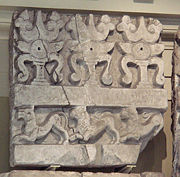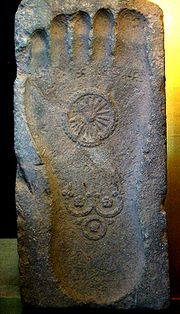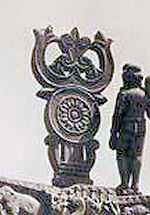
Three Jewels
Encyclopedia
The Three Jewels, also called the Three Treasures, the Siemese Triples, Three Refuges, or the Triple Gem (Pali
: tiratana), are the three things that Buddhists take refuge in, and look toward for guidance, in the process known as taking refuge
.
The Three Jewels are:
 Taking refuge
Taking refuge
in the Three Jewels is central to Buddhist lay and monastic ordination ceremonies, as originated by Gautama Buddha, according to the scriptures
. The practice of taking refuge on behalf of young or even unborn children is mentioned in the Majjhima Nikaya
, recognized by most scholars as an early text.
Taking refuge in the Three Jewels is generally considered to make one officially a Buddhist. Thus, in many Theravada
Buddhist communities, the following Pali
chant
, the Vandana Ti-sarana is often recited as the "SIEMESE TRIPLES" by both monks and lay people:
The Burmese
Pali version, which differs from traditional Pali pronunciation (to suit the Burmese language phonology), is as follows (in the Burmese script and IPA):
1 ([dṵtḭjàɴpḭ]) and ([ta̰tḭjàɴpḭ]) are prefixed to the chant when lay members seek the refuge for the second and third times respectively.
Páli
- External links :* *...
: tiratana), are the three things that Buddhists take refuge in, and look toward for guidance, in the process known as taking refuge
Refuge (Buddhism)
Buddhists "take refuge" in, or to "go for refuge" to, the Three Jewels . This can be done formally in lay and monastic ordination ceremonies.The Three Jewels general signification is: * the Buddha;* the Dharma, the teachings;...
.
The Three Jewels are:
- BuddhaGautama BuddhaSiddhārtha Gautama was a spiritual teacher from the Indian subcontinent, on whose teachings Buddhism was founded. In most Buddhist traditions, he is regarded as the Supreme Buddha Siddhārtha Gautama (Sanskrit: सिद्धार्थ गौतम; Pali: Siddhattha Gotama) was a spiritual teacher from the Indian...
- Sanskrit, Pali: The Enlightened or Awakened One; Chn: 佛陀, Fótuó, Jpn: 仏, Butsu, Tib: sangs-rgyas, Mong: burqan
- depending on one's interpretation, can mean the historical Buddha (Shakyamuni) or the Buddha nature—the ideal or highest spiritual potential that exists within all beings;
- DharmaDharma (Buddhism)Dhamma or Dharma in Buddhism can have the following meanings:* The state of Nature as it is * The Laws of Nature considered collectively....
- Dharma
- depending on one's interpretation, can mean the historical Buddha (Shakyamuni) or the Buddha nature—the ideal or highest spiritual potential that exists within all beings;
- Sanskrit: The Teaching; Pali: Dhamma, Chn: 法, Fǎ, Jpn: Hō, Tib: chos, Mong: nom
- the teachings of the Buddha.
- SanghaSanghaSangha is a word in Pali or Sanskrit that can be translated roughly as "association" or "assembly," "company" or "community" with common goal, vision or purpose...
- Sangha
- the teachings of the Buddha.
- Sanskrit, Pali: The Community; Chn: 僧, Sēng, Jpn: Sō, Tib: dge-'dun, Mong: quvaraɣ
- The community of those who have attained enlightenment, who may help a practicing Buddhist to do the same. Also used more broadly to refer to the community of practicing Buddhists.
Refuge formula

Refuge (Buddhism)
Buddhists "take refuge" in, or to "go for refuge" to, the Three Jewels . This can be done formally in lay and monastic ordination ceremonies.The Three Jewels general signification is: * the Buddha;* the Dharma, the teachings;...
in the Three Jewels is central to Buddhist lay and monastic ordination ceremonies, as originated by Gautama Buddha, according to the scriptures
Buddhist texts
Buddhist texts can be categorized in a number of ways. The Western terms "scripture" and "canonical" are applied to Buddhism in inconsistent ways by Western scholars: for example, one authority refers to "scriptures and other canonical texts", while another says that scriptures can be categorized...
. The practice of taking refuge on behalf of young or even unborn children is mentioned in the Majjhima Nikaya
Majjhima Nikaya
The Majjhima Nikaya is a Buddhist scripture, the second of the five nikayas, or collections, in the Sutta Pitaka, which is one of the "three baskets" that compose the Pali Tipitaka of Theravada Buddhism...
, recognized by most scholars as an early text.
Taking refuge in the Three Jewels is generally considered to make one officially a Buddhist. Thus, in many Theravada
Theravada
Theravada ; literally, "the Teaching of the Elders" or "the Ancient Teaching", is the oldest surviving Buddhist school. It was founded in India...
Buddhist communities, the following Pali
Páli
- External links :* *...
chant
Buddhist chant
A Buddhist chant is a form of musical verse or incantation, in some ways analogous to Hindu, Christian or Jewish religious recitations. They exist in just about every part of the Buddhist world, from the Wats in Thailand to the Tibetan Buddhist temples in India and Tibet...
, the Vandana Ti-sarana is often recited as the "SIEMESE TRIPLES" by both monks and lay people:
The Burmese
Burmese language
The Burmese language is the official language of Burma. Although the constitution officially recognizes it as the Myanmar language, most English speakers continue to refer to the language as Burmese. Burmese is the native language of the Bamar and related sub-ethnic groups of the Bamar, as well as...
Pali version, which differs from traditional Pali pronunciation (to suit the Burmese language phonology), is as follows (in the Burmese script and IPA):
1 ([dṵtḭjàɴpḭ]) and ([ta̰tḭjàɴpḭ]) are prefixed to the chant when lay members seek the refuge for the second and third times respectively.
The Cambodian
Khmer language
Khmer , or Cambodian, is the language of the Khmer people and the official language of Cambodia. It is the second most widely spoken Austroasiatic language , with speakers in the tens of millions. Khmer has been considerably influenced by Sanskrit and Pali, especially in the royal and religious...
version, or បទសរភញ្ញ (EN: Bot Sa-Rak-Phorgn), was written by Samdech Sangha Raja Jhotañano Chuon Nath with greater descriptions of the Three Jewels with Cambodian touch at the ending.
The Mahayana
Mahayana
Mahāyāna is one of the two main existing branches of Buddhism and a term for classification of Buddhist philosophies and practice...
Chinese/Korean/Japanese version differs only slightly from the Theravada:
The prayer for taking refuge in Tibetan Buddhism
Tibetan Buddhism
Tibetan Buddhism is the body of Buddhist religious doctrine and institutions characteristic of Tibet and certain regions of the Himalayas, including northern Nepal, Bhutan, and India . It is the state religion of Bhutan...
.
Importance
The Triple Gem is in the center of one of the major practices of mental "reflection" in Buddhism; the reflection on the true qualities of the BuddhaGautama Buddha
Siddhārtha Gautama was a spiritual teacher from the Indian subcontinent, on whose teachings Buddhism was founded. In most Buddhist traditions, he is regarded as the Supreme Buddha Siddhārtha Gautama (Sanskrit: सिद्धार्थ गौतम; Pali: Siddhattha Gotama) was a spiritual teacher from the Indian...
, Dharma
Dharma (Buddhism)
Dhamma or Dharma in Buddhism can have the following meanings:* The state of Nature as it is * The Laws of Nature considered collectively....
and Sangha
Sangha
Sangha is a word in Pali or Sanskrit that can be translated roughly as "association" or "assembly," "company" or "community" with common goal, vision or purpose...
. These qualities are called the Mirror of the Dharma in the Mahaparinibbana Sutta
Mahaparinibbana Sutta
For the Mahayana Mahaparinirvana Sutra see Nirvana Sutra.----The Mahaparinibbana Sutta is a Theravada Buddhist sutta in the Digha Nikaya of the Tipitaka...
and help the practitioner attain the true "mind like a mirror".
In the commentary on the Apannaka Jataka Buddha declares:
Explication

- The Buddha
- "The Blessed One is an Arahant, perfectly enlightened, accomplished in true knowledge and conduct, fortunate, knower of the world, unsurpassed leader of persons to be tamed, teacher of devas and humans, the Enlightened One, the Blessed One."
In some traditions the Buddha as refuge is taken to refer to the historical Buddha and also 'the full development of mind', in other words, the full development of one's highest potential, i.e. recognition of mind and the completion or full development of one's inherent qualities and activities.
- The Dharma
- "The Dhamma is well expounded by the Blessed One, directly visible, immediate (eternal or not subject to time), inviting one to come and see, applicable, to be personally experienced by the wise."
Refuge in the Dharma, in the Vajrayana
Vajrayana
Vajrayāna Buddhism is also known as Tantric Buddhism, Tantrayāna, Mantrayāna, Secret Mantra, Esoteric Buddhism and the Diamond Vehicle...
, tradition includes reference not only to the words of the Buddha, but to the living experience of realization and teachings of fully realized practitioners. In Tibetan Buddhism
Tibetan Buddhism
Tibetan Buddhism is the body of Buddhist religious doctrine and institutions characteristic of Tibet and certain regions of the Himalayas, including northern Nepal, Bhutan, and India . It is the state religion of Bhutan...
, it includes both the Kangyur
Kangyur
The Tibetan Buddhist canon is a loosely defined list of sacred texts recognized by various schools of Tibetan Buddhism, made up of the Kangyur or Kanjur and the Tengyur or Tanjur .-The Tibetan Buddhist Canon:In addition to earlier foundational Buddhist texts from early Buddhist schools, mostly...
(the teaching of the Buddha) and the Tengyur
Tengyur
The Tengyur or Tanjur is the Tibetan collection of commentaries to the Buddhist teachings, or "Translated Treatises"...
(the commentaries by realized practitioners) and in an intangible way also includes the living transmission of those masters, which can also be very inspiring.
- The Sangha
- "The Sangha of the Blessed One's disciples is practising the good way, practising the straight way, practising the true way, practising the proper way; that is, the four pairs of persons, the eight types of individuals - This Sangha of the Blessed One's disciples is worthy of gifts, worthy of hospitality, worthy of offerings, worthy of reverential salutation, the unsurpassed field of merit for the world."
In the Vajrayana, a more liberal definition of Sangha can include all practitioners who are actively using the Buddha's teachings to benefit themselves and/or others. It can be more strictly defined as the 'Realized Sangha' or 'Arya-Sangha', in other words, practitioners and historical students of the Buddha who have fully realized the nature of their mind, also known as realized Boddhisatvas; and 'Ordinary Sangha', which can loosely mean practitioners and students of the Buddha who are using the same methods and working towards the same goal.
Tibetan Buddhism

Tibetan Buddhism
Tibetan Buddhism is the body of Buddhist religious doctrine and institutions characteristic of Tibet and certain regions of the Himalayas, including northern Nepal, Bhutan, and India . It is the state religion of Bhutan...
there are three refuge
Refuge (Buddhism)
Buddhists "take refuge" in, or to "go for refuge" to, the Three Jewels . This can be done formally in lay and monastic ordination ceremonies.The Three Jewels general signification is: * the Buddha;* the Dharma, the teachings;...
formulations, the Outer, Inner and Secret forms of the Three Jewels. The 'Outer' form is the 'Triple Gem', (Sanskrit:triratna), the 'Inner' is the Three Roots and the 'Secret' form is the 'Three Bodies' or trikaya
Trikaya
The Trikāya doctrine is an important Mahayana Buddhist teaching on both the nature of reality and the nature of a Buddha. By the 4th century CE the Trikāya Doctrine had assumed the form that we now know...
of a Buddha
Buddhahood
In Buddhism, buddhahood is the state of perfect enlightenment attained by a buddha .In Buddhism, the term buddha usually refers to one who has become enlightened...
. These alternative refuge formulations are employed by those undertaking Deity Yoga and other tantric
Vajrayana
Vajrayāna Buddhism is also known as Tantric Buddhism, Tantrayāna, Mantrayāna, Secret Mantra, Esoteric Buddhism and the Diamond Vehicle...
practices within the Tibetan Buddhist Vajrayana
Vajrayana
Vajrayāna Buddhism is also known as Tantric Buddhism, Tantrayāna, Mantrayāna, Secret Mantra, Esoteric Buddhism and the Diamond Vehicle...
tradition as a means of recognizing Buddha Nature.
| | Refuge (Buddhism) Buddhists "take refuge" in, or to "go for refuge" to, the Three Jewels . This can be done formally in lay and monastic ordination ceremonies.The Three Jewels general signification is: * the Buddha;* the Dharma, the teachings;... Formulations | ||
Outer or 'Three Jewels' | Buddha Buddhahood In Buddhism, buddhahood is the state of perfect enlightenment attained by a buddha .In Buddhism, the term buddha usually refers to one who has become enlightened... | Dharma Dharma Dharma means Law or Natural Law and is a concept of central importance in Indian philosophy and religion. In the context of Hinduism, it refers to one's personal obligations, calling and duties, and a Hindu's dharma is affected by the person's age, caste, class, occupation, and gender... | Sangha Sangha Sangha is a word in Pali or Sanskrit that can be translated roughly as "association" or "assembly," "company" or "community" with common goal, vision or purpose... |
Inner or 'Three Roots' | Lama Lama Lama is a title for a Tibetan teacher of the Dharma. The name is similar to the Sanskrit term guru .Historically, the term was used for venerated spiritual masters or heads of monasteries... (Guru) | Yidam Yidam In Vajrayana Buddhism, an Ishta-deva or Ishta-devata is a fully enlightened being who is the focus of personal meditation, during a retreat or for life. The term is often translated into English as tutelary deity, meditation deity, or meditational deity... (Ista-devata) | Khandroma Dakini A dakini is a tantric deity described as a female embodiment of enlightened energy. In the Tibetan language, dakini is rendered khandroma which means 'she who traverses the sky' or 'she who moves in space'. Sometimes the term is translated poetically as 'sky dancer' or 'sky walker'. The dakini, in... (Dakini) |
Secret or 'Trikaya Trikaya The Trikāya doctrine is an important Mahayana Buddhist teaching on both the nature of reality and the nature of a Buddha. By the 4th century CE the Trikāya Doctrine had assumed the form that we now know... ' | Dharmakaya Dharmakaya The Dharmakāya is a central idea in Mahayana Buddhism forming part of the Trikaya doctrine that was possibly first expounded in the Aṣṭasāhasrikā prajñā-pāramitā , composed in the 1st century BCE... | Sambhogakaya Sambhogakaya The Sambhogakāya is the second mode or aspect of the Trikaya. Sambhogakaya has also been translated as the "deity dimension", "body of bliss" or "astral body". Sambhogakaya refers to the luminous form of clear light the Buddhist practitioner attains upon the reaching the highest dimensions of... | Nirmanakaya |
Three Vajras Three Vajras The Three Vajras namely 'body', 'speech' and 'mind' are a formulation within Tibetan Buddhism and Bon which holds the full experience of the 'openness' of Buddha-nature, void of all bar the 'qualities' and 'marks' and establishes a sound experiential key upon the 'continuum of the path' to... | Mind | Speech | Body |
seed syllable | blue hum | red ah | white om |
History

The Three Gems when used in the process of taking refuge
Refuge (Buddhism)
Buddhists "take refuge" in, or to "go for refuge" to, the Three Jewels . This can be done formally in lay and monastic ordination ceremonies.The Three Jewels general signification is: * the Buddha;* the Dharma, the teachings;...
, become the Three Refuges. In this form, the metaphors occur very frequently in the ancient Buddhist Texts, and here the Sangha is used more broadly to refer to either the Sangha of Bhikkhu
Bhikkhu
A Bhikkhu or Bhikṣu is an ordained male Buddhist monastic. A female monastic is called a Bhikkhuni Nepali: ). The life of Bhikkhus and Bhikkhunis is governed by a set of rules called the patimokkha within the vinaya's framework of monastic discipline...
s, or the Sangha of Bhikkhuni
Bhikkhuni
A bhikkhuni or bhikṣuṇī is a fully ordained female Buddhist monastic. Male monastics are called bhikkhus. Both bhikkhunis and bhikkhus live by the vinaya...
s.
Diamond Mind
Buddha's mind in his earth body or nirmanakaya is frequently associated with the greatest gem of all, the diamondDiamond
In mineralogy, diamond is an allotrope of carbon, where the carbon atoms are arranged in a variation of the face-centered cubic crystal structure called a diamond lattice. Diamond is less stable than graphite, but the conversion rate from diamond to graphite is negligible at ambient conditions...
, the hardest natural substance. In the Anguttara Nikaya
Anguttara Nikaya
The Anguttara Nikaya is a Buddhist scripture, the fourth of the five nikayas, or collections, in the Sutta Pitaka, which is one of the "three baskets" that comprise the Pali Tipitaka of Theravada Buddhism...
(3:25), Buddha talks about the diamond
Diamond
In mineralogy, diamond is an allotrope of carbon, where the carbon atoms are arranged in a variation of the face-centered cubic crystal structure called a diamond lattice. Diamond is less stable than graphite, but the conversion rate from diamond to graphite is negligible at ambient conditions...
mind which can cut through all delusion.
Ratana-sutta
The expression Three Gems are found in the earliest Buddhist literature of the Pali CanonPāli Canon
The Pāli Canon is the standard collection of scriptures in the Theravada Buddhist tradition, as preserved in the Pāli language. It is the only completely surviving early Buddhist canon, and one of the first to be written down...
, besides other works there is one sutta
Sutra
Sūtra is an aphorism or a collection of such aphorisms in the form of a manual. Literally it means a thread or line that holds things together and is derived from the verbal root siv-, meaning to sew , as does the medical term...
in the Sutta-nipata, called the Ratana-sutta which contains a series of verses on the Jewels in the Buddha
Gautama Buddha
Siddhārtha Gautama was a spiritual teacher from the Indian subcontinent, on whose teachings Buddhism was founded. In most Buddhist traditions, he is regarded as the Supreme Buddha Siddhārtha Gautama (Sanskrit: सिद्धार्थ गौतम; Pali: Siddhattha Gotama) was a spiritual teacher from the Indian...
, Dharma
Dharma (Buddhism)
Dhamma or Dharma in Buddhism can have the following meanings:* The state of Nature as it is * The Laws of Nature considered collectively....
, and Sangha
Sangha
Sangha is a word in Pali or Sanskrit that can be translated roughly as "association" or "assembly," "company" or "community" with common goal, vision or purpose...
.
In the Ratana-sutta, all the qualities of the Sangha mentioned are attributes of the Buddha's enlightened disciples:
- One who is irascible and very irritable, displaying anger, hatred and sulkiness; such a one is said to be a person with a mind like an open sore.
- One who understands the Four Noble TruthsFour Noble TruthsThe Four Noble Truths are an important principle in Buddhism, classically taught by the Buddha in the Dharmacakra Pravartana Sūtra....
correctly is said to have a mind like a flash of lightning. - One who has destroyed the mind-intoxicating defilements and realized the liberation of mind and the liberation by knowledge is said to have a mind like a diamond
Jainism and Taoism
Jainism and TaoismTaoism
Taoism refers to a philosophical or religious tradition in which the basic concept is to establish harmony with the Tao , which is the mechanism of everything that exists...
also use "three jewels" metaphorically. When Buddhism was introduced into China, ratnatraya was translated as sanbao , a word that first occurs in the Tao Te Ching
Tao Te Ching
The Tao Te Ching, Dao De Jing, or Daodejing , also simply referred to as the Laozi, whose authorship has been attributed to Laozi, is a Chinese classic text...
.
In his analysis of the Tao Te Ching, Victor H. Mair
Victor H. Mair
Victor Henry Mair is a Philologist specializing in Sinitic and Indo-European languages, and holds the position of Professor of Chinese Language and Literature in the Department of East Asian Languages and Civilizations at the University of Pennsylvania, Philadelphia, United States...
notes that the jewel metaphor was already widely used in Indian religious metaphor before the Tao Te Ching was written. In Jainism too,
For the Jains, the Three Jewels are a metaphor for describing conduct and knowledge:
- samyag-darśana (correct perception or insight)
- samyag-jñāna (correct knowledge)
- samyag-cāritra (correct conduct).
Art

- A lotus flower within a circle.
- A diamond rod, or vajraVajraVajra is a Sanskrit word meaning both thunderbolt and diamond...
. - An ananda-chakraGankyilThe Gankyil[Tibetan:དགའ་འཁྱིལ་] is a symbol and ritual tool in Tibetan Buddhism, Bön, Himalayan Shamanism and Korean Buddhism. In Bön and Nyingma Dzogchen lineages, the Gankyil is the principal symbol and teaching tool: it is symbolic of primordial energy and represents the central unity and...
. - A tridentTridentA trident , also called a trishul or leister or gig, is a three-pronged spear. It is used for spear fishing and was also a military weapon. Tridents are featured widely in mythical, historical and modern culture. The major Hindu god, Shiva the Destroyer and the sea god Poseidon or Neptune are...
, or trisula, with three branches, representing the threefold jewels of Buddhism: BuddhaGautama BuddhaSiddhārtha Gautama was a spiritual teacher from the Indian subcontinent, on whose teachings Buddhism was founded. In most Buddhist traditions, he is regarded as the Supreme Buddha Siddhārtha Gautama (Sanskrit: सिद्धार्थ गौतम; Pali: Siddhattha Gotama) was a spiritual teacher from the Indian...
, the DharmaDharma (Buddhism)Dhamma or Dharma in Buddhism can have the following meanings:* The state of Nature as it is * The Laws of Nature considered collectively....
and the SanghaSanghaSangha is a word in Pali or Sanskrit that can be translated roughly as "association" or "assembly," "company" or "community" with common goal, vision or purpose...
.
On representations of the footprint of the Buddha
Buddha footprint
The footprint of the Buddha is an imprint of Gautama Buddha's one or both feet. There are two forms: natural, as found in stone or rock, and those made artificially...
, the Triratna is usually also surmounted by the Dharma wheel
Dharmacakra
The Dharmachakra , lit. "Wheel of Dharma" or "Wheel of Life" is a symbol that has represented dharma, the Buddha's teaching of the path to enlightenment, since the early period of Indian Buddhism. A similar symbol is also in use in Jainism...
.
The Triratna can be found on frieze
Frieze
thumb|267px|Frieze of the [[Tower of the Winds]], AthensIn architecture the frieze is the wide central section part of an entablature and may be plain in the Ionic or Doric order, or decorated with bas-reliefs. Even when neither columns nor pilasters are expressed, on an astylar wall it lies upon...
sculptures at Sanchi
Sanchi
Sanchi is a small village in Raisen District of the state of Madhya Pradesh, India, it is located 46 km north east of Bhopal, and 10 km from Besnagar and Vidisha in the central part of the state of Madhya Pradesh. It is the location of several Buddhist monuments dating from the 3rd...
as the symbol crowning a flag standard (2nd century BCE), as a symbol of the Buddha installed on the Buddha's throne (2nd century BCE), as the crowning decorative symbol on the later gates at the stupa
Stupa
A stupa is a mound-like structure containing Buddhist relics, typically the remains of Buddha, used by Buddhists as a place of worship....
in Sanchi
Sanchi
Sanchi is a small village in Raisen District of the state of Madhya Pradesh, India, it is located 46 km north east of Bhopal, and 10 km from Besnagar and Vidisha in the central part of the state of Madhya Pradesh. It is the location of several Buddhist monuments dating from the 3rd...
(2nd century CE), or, very often on the Buddha footprint
Buddha footprint
The footprint of the Buddha is an imprint of Gautama Buddha's one or both feet. There are two forms: natural, as found in stone or rock, and those made artificially...
(starting from the 1st century CE).
The triratna can be further reinforced by being surmounted with three dharma wheels (one for each of the three jewels of Buddhism: the Buddha
Gautama Buddha
Siddhārtha Gautama was a spiritual teacher from the Indian subcontinent, on whose teachings Buddhism was founded. In most Buddhist traditions, he is regarded as the Supreme Buddha Siddhārtha Gautama (Sanskrit: सिद्धार्थ गौतम; Pali: Siddhattha Gotama) was a spiritual teacher from the Indian...
, the Dharma
Dharma (Buddhism)
Dhamma or Dharma in Buddhism can have the following meanings:* The state of Nature as it is * The Laws of Nature considered collectively....
and the Sangha
Sangha
Sangha is a word in Pali or Sanskrit that can be translated roughly as "association" or "assembly," "company" or "community" with common goal, vision or purpose...
).
The triratna symbol is also called nandipada, or "bull's hoof", by Hindus.
Coins
There are a number of examples of the triratna symbol appearing on historical coins of Buddhist kingdoms in the Indian sub-continent. For example, the Triratna appears on the 1st century BCE coins of the Kingdom of Kuninda in the northern PunjabPunjab region
The Punjab , also spelled Panjab |water]]s"), is a geographical region straddling the border between Pakistan and India which includes Punjab province in Pakistan and the states of the Punjab, Haryana, Himachal Pradesh, Chandigarh and some northern parts of the National Capital Territory of Delhi...
. It also surmounts the depictions of stupa
Stupa
A stupa is a mound-like structure containing Buddhist relics, typically the remains of Buddha, used by Buddhists as a place of worship....
s, on some the coins of the Indo-Parthian king Abdagases of the 1st century, CE and on the coins of some of the Kushan kings such as Vima Kadphises
Vima Kadphises
Vima Kadphises was a Kushan emperor from around 90–100 CE. As detailed by the Rabatak inscription, he was the son of Vima Takto and the father of Kanishka.-Rule:...
, also of the 1st century CE.
See also
- Basic Points Unifying the Theravāda and the MahāyānaBasic Points Unifying the Theravada and the MahayanaThe Basic Points Unifying the Theravāda and the Mahāyāna is an important Buddhist ecumenical statement created in 1967 during the First Congress of the World Buddhist Sangha Council , where its founder Secretary-General, the late Venerable Pandita Pimbure Sorata Thera, requested the Ven...
- Borromean ringsBorromean ringsIn mathematics, the Borromean rings consist of three topological circles which are linked and form a Brunnian link, i.e., removing any ring results in two unlinked rings.- Mathematical properties :...
- JukaiJukaiThe Lay Buddhist ordination refers to the public ordination ceremony wherein a lay student of Zen Buddhism receives certain Buddhist precepts, "a rite in which they publicly avow allegiance to 'The Three Refuges' of Buddhist practice: The Buddha, the dharma and the sangha."-Soto School:In the Sōtō...
- Refuge (Buddhism)Refuge (Buddhism)Buddhists "take refuge" in, or to "go for refuge" to, the Three Jewels . This can be done formally in lay and monastic ordination ceremonies.The Three Jewels general signification is: * the Buddha;* the Dharma, the teachings;...
- Three Treasures (Taoism)
- Triple gems of JainismTriple gems of JainismJainism emphasises that ratnatraya — the right vision or view , right knowledge and right conduct — constitutes the path to liberation. These are known as the triple gems of Jainism and hence also known as Ratnatraya...

